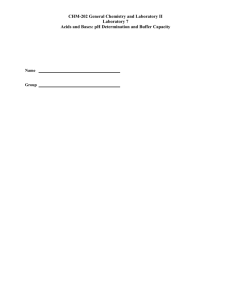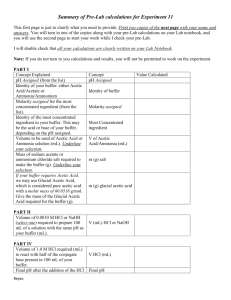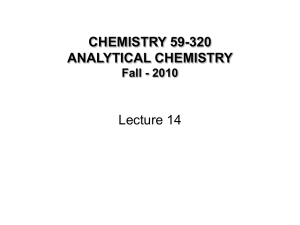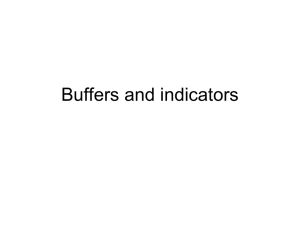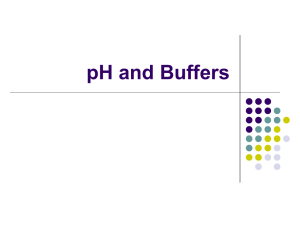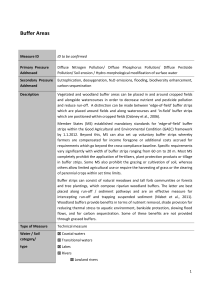Buffers - RIT
advertisement
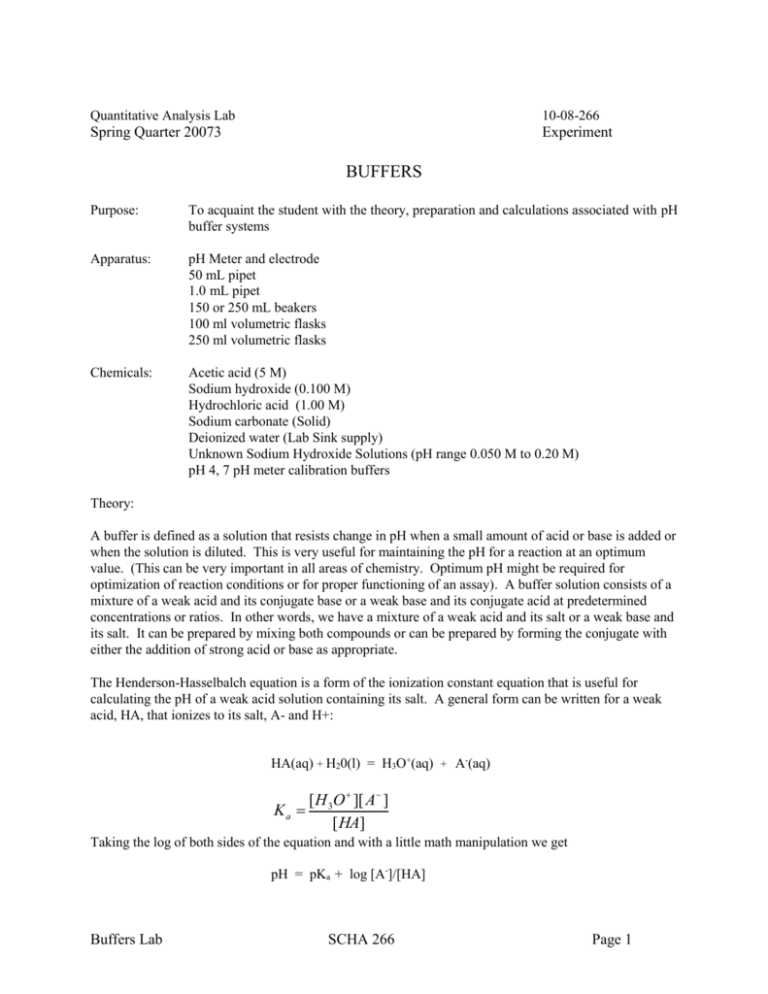
Quantitative Analysis Lab 10-08-266 Spring Quarter 20073 Experiment BUFFERS Purpose: To acquaint the student with the theory, preparation and calculations associated with pH buffer systems Apparatus: pH Meter and electrode 50 mL pipet 1.0 mL pipet 150 or 250 mL beakers 100 ml volumetric flasks 250 ml volumetric flasks Chemicals: Acetic acid (5 M) Sodium hydroxide (0.100 M) Hydrochloric acid (1.00 M) Sodium carbonate (Solid) Deionized water (Lab Sink supply) Unknown Sodium Hydroxide Solutions (pH range 0.050 M to 0.20 M) pH 4, 7 pH meter calibration buffers Theory: A buffer is defined as a solution that resists change in pH when a small amount of acid or base is added or when the solution is diluted. This is very useful for maintaining the pH for a reaction at an optimum value. (This can be very important in all areas of chemistry. Optimum pH might be required for optimization of reaction conditions or for proper functioning of an assay). A buffer solution consists of a mixture of a weak acid and its conjugate base or a weak base and its conjugate acid at predetermined concentrations or ratios. In other words, we have a mixture of a weak acid and its salt or a weak base and its salt. It can be prepared by mixing both compounds or can be prepared by forming the conjugate with either the addition of strong acid or base as appropriate. The Henderson-Hasselbalch equation is a form of the ionization constant equation that is useful for calculating the pH of a weak acid solution containing its salt. A general form can be written for a weak acid, HA, that ionizes to its salt, A- and H+: HA(aq) + H20(l) = H3O+(aq) + A-(aq) Ka [ H 3O ][ A ] [ HA] Taking the log of both sides of the equation and with a little math manipulation we get pH = pKa + log [A-]/[HA] Buffers Lab SCHA 266 Page 1 If the solution is diluted, the ratio of base to acid remains constant so the pH of the solution does not change. The buffer will be able to neutralize the same number of moles of acid or base. However, the buffer capacity of the system, the amount of acid or base that can be added without causing a large change in pH, would be decreased. Buffer Capacity = = (number of moles of OH- or H3O+ added) (pH change)(volume of buffer in L) The buffering capacity is maximum where pH = pKa. In general, the buffering capacity is satisfactory over the pH range of pKa ± 1. The mixture of a weak acid and its salt may also be obtained by mixing an excess of weak acid with some strong base to produce the salt by neutralization or by mixing an excess of salt with a strong acid to produce the weak acid component of the buffer. Procedure: Part A Step 1: Dilute the appropriate amount of the stock Acetic acid ( CH3COOH) to make 250 ml of 0.20 M solution and 250 ml of 0.020 M solution. Measure the original pH of each solution. Calculate the theoretical values of these solutions. Step 2: Prepare 250 ml of 0.10 M NaOH and 250 mL 0.010 M NaOH. Calculate the the theoretical values of these solutions. Step 3: Prepare a buffer solution by combining 50 mL of 0.20M CH3COOH with 50 mL of 0.10M NaOH. Measure the pH of this buffer. Calculate the theoretical value of this buffer solution. Compare the experimental and theoretical values. Step 4: Add 1.0 ml of 1.00 M HC1 to the buffer prepared in step 3. Also add 1.00 mL of 1.00 M HCl into a beaker of 100 mL distilled water. Measure the pH of the resultant solutions. Compare the experimental and theoretical values. Step 5: Add 1.0 mL of a 1.00 M HCl to a buffer solution prepared from the combination of 50 ml 0.020 M CH3COOH and 50.0 mL of 0.010 M NaOH. Compare the experimental and theoretical values. Part B Using sodium carbonate make a buffer solution (0.10 M) at the appropriate pH range, you will need to look up the pKa’s. The calculations and methodology are to be designed by you and approved by the instructor. You will need to prove that it is indeed a buffer solution by the addition of a base solution of an unknown molarity. You will use your resulting pH to determine Buffers Lab SCHA 266 Page 2 the molarity of the unknown base. Buffers Lab SCHA 266 Page 3 Name _________________ Quantitative Analysis Section _________ Report Sheet Buffer Experiment Part A Table I. Results for Acetate Buffer Experiment Exp # Reading # > Trial 1 1 pH 0.20 M Acetic Acid 2 pH 0.020 M Acetic Acid 3 pH 0.10 M NaOH 4 pH 0.0010 M NaOH 5 Step 3: Buffer Solution pH 6 Step 4: Water pH after HCl addition 7 Step 4: Buffer pH after HCl addition 8 Step 5: Buffer Solution pH 9 Step 5: Buffer pH after HCl addition Trial 2 Trial 3 Theoretical pH Part B Table II. Results for Carbonate Buffer Experiment 11 Reading # > 1 2 12 Buffer Solution pH 13 Buffer after base addition pH 14 Calculated base Molarity 3 Theoretical pH Attach notebook pages with calculations, showing all work. Include a brief conclusion in your notebook.. BE PREPARED BEFORE LAB!!!!!! Buffers Lab SCHA 266 Page 4

